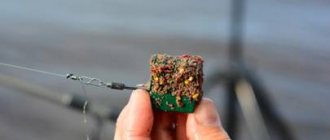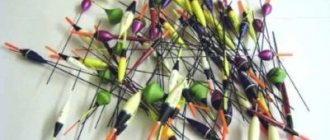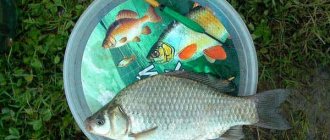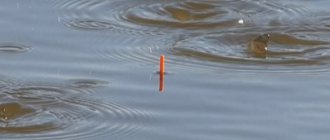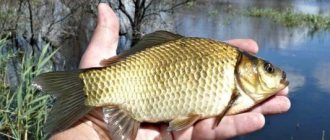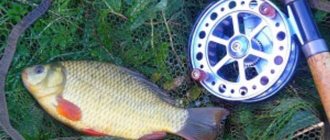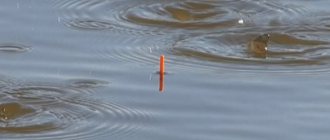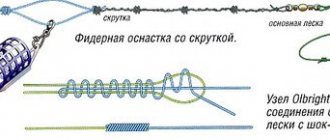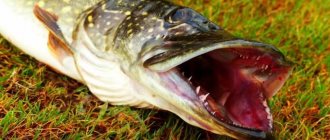Which float is best to use for crucian carp
Before considering specific models, you need to understand its structure. They all consist of:
- Antennas
- Bodies
- Kiel
After changing certain design features of the alarms, they radically change their operating principle and purpose. Once you understand and understand what each element is responsible for, you can easily learn to make a choice depending on the conditions.
How do they differ from each other:
- Material of manufacture. Strength and durability.
- Long keel. Responsible for stability in wind and current.
- Load capacity. Wind resistance.
- Appointment. For what type of reservoir?
- Antenna length. Visibility of bites.
- Body shape. Adjusts sensitivity.
- Size. The stronger the wind, the larger it is.
The best for crucian carp would be a symmetrical spindle-shaped float with different ratios of length and width. The most common option is 1 to 7, where:
- Width 1 cm
- Length 7 cm
When properly loaded they have amazing sensitivity. No other type compares to them. They are universal and are used in standing reservoirs and on rivers with a current. By changing the weight upward, resistance to waves and wind increases.
The carrying capacity is selected depending on the fishing conditions:
- In calm water: 2-3 g
- In windy conditions: 5-7 degrees
- For long casts: 10 g
Keep in mind that as the weight increases, the sensitivity of the gear decreases. Always try to install the lightest ones, increasing the load capacity only due to adverse conditions. Now let's move away from the general concept and look at the specifics, how to learn to make a choice depending on the conditions.
Choosing the right uniform for the weather
Unfortunately, the weather is not always calm - the favorite condition of the floater. At such times, you can put on the lightest gear, noticing uncertain and cautious bites. But what to do when, upon arriving at a pond, you encounter wind and waves, in general, all the joys of nature? Using a 2-3 gram model you simply won’t understand anything. At the same time, they can be placed on their side or sunk. Below we have described the basics of choice depending on the conditions.
Choice depending on weather conditions:
- Olive: slight wind, weak current. Poor transmission of bites on the rise.
- Ball: for medium to strong currents. They almost do not react when bitten by drowned fish.
- Extended: excellent for still water, light currents and light winds
- Drop-shaped with a narrowing towards the bottom: stable on the wave, excellent on rising bites
- Flat: for flow, low sensitivity
- Drop-shaped with a narrowed upper part: medium wind, medium current.
The best manufacturers
The stores have a lot of offers from both famous and unknown manufacturers. For amateur fishing, any float that matches the recommendations given above will be sufficient. Don't chase low prices. The price is determined by the material, quality and brand. If everything is clear with the latter, then let’s take a closer look at the first two.
The best materials are:
- Antenna: plastic
- Body: balsa
- Keel: carbon
It is important that the antenna and keel are held tightly and securely in the body. At the same time, having small dimensions they remained durable. Modern materials have all these advantages: plastic and carbon. Balsa is the lightest tree in the world. Using it you get the best quality for relatively little money. Additionally, it is treated with a layer of varnish that protects the body from moisture.
Popular manufacturers:
- Expert
- Salmo
- Xtro
- Tubertini
- Maver
- Colmic
- Milo
There are a huge number of types of floats, each of which can be ideal for its own fishing conditions.
Further, I will be guided by personal experience, which should not interfere with trying, experimenting and finding your own solutions.
It’s probably worth starting with determining the parameters of the floats - weight, carrying capacity, shape.
Weight and carrying capacity are completely different concepts, which, as it turned out, not all fishermen know about, even with great experience.
By weight we mean directly how much the float itself weighs, and this weight can be completely different for the same size, due to its preliminary loading (a load is already built into the float),
Also, pre-loaded floats will not allow you to “measure the depth” in the traditional way - if it is not standing straight, then the depth is less than the set one. This float is always in a vertical position.
What can such a float do? “It allows you to get by with less weight on the line, or even without it at all, which will have a positive effect in some cases, for example, when catching particularly cautious fish, or at very shallow depths. Fewer unnecessary parts, less frightening of the fish, less chance of getting hooked.
The weight of the float (of course, you need to take into account the weight of all the equipment) plays a role in casting distance, resistance to waves, wind and current.
Load capacity is the maximum weight of a sinker it can hold while remaining afloat.
Usually the “working” weight is indicated on the floats - with this weight the float is in the working condition determined by the manufacturer, that is, only the top sticks out of the water at some level.
Float shapes usually vary from completely spherical to gradually tapering down to a straight rod.
There are even more exotic forms, often homemade.
If we describe in a nutshell what floats are used and where, it would be something like this:
the stronger the current and the wind, the more round and heavy the float can be, for example, on a mountain river, when fishing for grayling, experimentally I reached a float without a keel and a top - well, it’s just not convenient with them.
Likewise in terms of depth, the heavier the tackle, the faster it will sink to the bottom, especially in the presence of a current. And at great depths and strong currents, it is simply not realistic to lower a light load to the bottom.
When there is still water without wind and when fishing for cautious fish, on the contrary, a light, long and narrow float will allow you to observe any touch of the fish to the nozzle.
Parameter of the float's resistance to lowering or rising.
When biting, the fish either pulls the float down or, on the contrary, lifts the bait, and the float either sinks or floats, respectively. And here, in addition to its resistance to the lifting force, which is trying to push it to the surface, its resistance to the flow of water arises. Ideally, the thinner the float, the less its resistance to water will be, but to give it a greater carrying capacity it is necessary to increase the size.
The most versatile here would be a spindle-shaped float. You can also choose a longer, but thinner one, to reduce lateral resistance if the fish moves to the side. Again, all this works in calm water, but in a current, a large length will only interfere. And the long tip sticking out of the water will work like a sail in the wind.
In a strong wind, a float with a flatter top (drop-up shape) will perform more positively; of course, the main part should be under water.
But, all these negative properties can be used for your benefit,
for example, when guiding with the current, if there is a wind counter to the current, you can specifically use the windage of the float so that the tackle is slightly slowed down.
In general, many modern floats are designed in advance so that in the operating position only the tip of the tip sticks out of the water, literally from 5 to 10-20mm.
Separately, floats can be distinguished when catching predators with live bait.
The main criterion here is suitable load capacity. The float is selected based on the size of the live bait, so that it cannot drown it. Otherwise, for example when fishing for pike, all parameters are not critical; they are selected based on experience and conditions.
How to load correctly
Don't repeat the mistakes of the majority, always make sure you load correctly. The timeliness of hooking and, as a result, the catch depends on it. Never use one ball of the sinker; this is the most common and serious omission.
Procedure:
- Clamp the smallest weight (underweight) 10-15 cm above the hook
- Next, after 15-20 cm in increments of 5-7 cm, mount the next 3-4 pellets
- Having equipped 1-2 pellets, check the depth; only the antenna should stick out from the water
- If it is recessed too much, reduce the weight and vice versa.
If you loaded the alarm correctly, its body will be completely hidden in the water, and only the antenna will remain sticking out. It’s not very convenient to set up at home, since there are no such containers for immersing the float, a bottle and a bucket will not work - you simply won’t have enough depth. Thanks to the grazing, the crucian carp will not feel resistance and will boldly take the bait. Follow all the recommendations while on the pond, it will take you 10 minutes.
Equipment for standing water
Floats for still water have an elongated body with a thin upper part, which perfectly shows bites on the sink and on the rise. A typical representative of this type is the Briscola series 241. Such floats register even the most cautious bites, for example of crucian carp, they work well at the stage of immersion of the equipment, and the minimum weight of the feed, which is enough to clearly record a bite, does not alarm the fish at all. Strongly elongated floats are not used for active play with equipment, but the upper fastening of the fishing line still allows for slight animation. These are, as a rule, pulls of minimal amplitude and speed - only to make the nozzle move slightly, in extreme cases, slowly move a few centimeters at the bottom. In still water this is often enough to provoke fish. In addition, thanks to the thin upper part, the float behaves well on small waves or ripples, leaving the nozzle motionless, which is often extremely important when fishing for crucian carp or crucian carp from the bottom. The usual carrying capacity of such equipment is from 0.5 to 2 g. At greater depths and for cases of more active play, floats of slightly more compact designs are used. Their feature is a more pronounced thickening of the body, which significantly increases stability. A good example of a float for this rig would be the Briscola 242 series. This type of float is excellent for catching a wide variety of fish (be it roach or bream, carp or crucian carp) in still water. This float perfectly captures all bite options and allows for fairly active play with the bait - not only small movements along the bottom, but also vertical animation in the water column and near the bottom. Such work with tackle turns out to be tempting for any fish, especially those actively searching for food and feeding. A more stable design of the equipment allows it to successfully withstand weak (primarily wind) currents. The typical carrying capacity of such rigs, depending on the depth and the expected fish, is from 1 to 3, less often 4, g. The third type of rigs is for great depths, it can be successfully used in large bodies of water (lakes, reservoirs), where even wind currents can be significant, when fishing for bream, roach, silver bream. For such equipment, floats are used, in which the body has a significant thickening, due to which stability and load-carrying capacity are increased. Prominent representatives of floats for such equipment will be the Briscola models of the 243 and 244 series. The latter is generally a “universal soldier”, can be used in a wide range of fishing conditions, even in light currents. The center of gravity of the float in the lower part and, accordingly, increased stability allow you to fish in a decent wave without losing control of the tackle. With such equipment, you can actively work with the tackle, even doing intense pulls, which lift the bait high in the water column. This game is very attractive for roach and silver bream. And the thin part of the float in front of the antenna captures bites well both on the sink and on the rise. The carrying capacity of these rigs directly depends on the depth and strength of the current (wind) and ranges from 2 to 4-6 g. I’ll digress a little from the topic of rigs and give an explanation about the bites. My considerable experience in fishing with a fly rod and plug shows that the type of bite is largely determined by the gear used. So, when fishing with a plug in a current (even a weak one) and actively playing with the rig, there are very few bites for the rise of bream, which usually feeds from the bottom and lifts the bait. In some cases, you can completely neglect them and make hooks only on sure bites on drownings. In the same conditions, but when fishing with a fly rod, rising bites will prevail, which means it is necessary to choose floats that perfectly fix them and allow for effective hooking.
Selection depending on reservoir conditions
Any environmental conditions dictate their own rules, to which the angler must adapt. There is no universal bite alarm; a float rod as a whole is assembled for specific tasks.
In still water
In calm weather and in still water, the "extended spindle" and "needle" are the best choice. These two forms provide the best sensitivity and excellent stability. Thanks to them, you won’t miss a single bite and will hook the crucian carp on time.
On the current
Water flows create additional stress. Depending on the strength of this load, the float is selected. For example, olive and elongated ones are perfect for small currents, and flat shapes for large ones. Remember, the more complex the conditions and the more sophisticated the form, the more difficult it is to determine the bite, but there is nothing you can do about it.
Types of floats
All float products perform the same function - they report a bite. Essentially, the principle of operation is the same. When the fish starts to bite, then the bite indicator reacts and begins to move or sink.
Floats differ in shape, weight, size, color and type of material from which they are made.
Conventionally, they can be divided into several types:
Teardrop-shaped. Very good for deep fishing. It has a low center of gravity, is very stable and shows a bite even in choppy water.
Spindle. This species is very sensitive and is needed for catching cautious fish. It is advisable to use only for fishing in still water (stakes, lakes, ponds) with a depth of no more than three meters.
Flat. Needed to fish in strong currents. Fishermen mainly use it for fishing in rivers. It looks like a disk to which, at an angle of forty-five degrees, an antenna with a keel is attached.Ball. Very stable in strong winds.
Straight. One of the most common. It has a rather simple shape. Suitable for fishing in good weather, in reservoirs with a depth of up to two meters.
Read here How to make a zakidushka with your own hands - a step-by-step description of making the best models and a description of their use (145 photos and videos)
Inverted drop. An ideal choice for fishing at great depths with underwater currents.
Olive. Used under different fishing conditions: waves, wind, calm weather. A fairly stable float, and essentially universal.
Double sided cone. Suitable for fishing on canals with weak and medium water flow. Very stable due to the long keel.
We put a float under certain tackles
If you are ready to go even further and choose a model for a specific gear, then we advise you to read our recommendations. This is not practical for beginners, believe me, basic knowledge is enough for you.
- Match: short and heavy body, long antenna visible from afar.
- Bolognese: the main condition is a long keel
- Flywheel: the lightest models
Sliding equipment
Used when the distance from the shore and the depth exceed the length of the rod. For example, you cast as far as possible and in this place there is a hole of 4 meters. Just imagine how you will do this if you use blind equipment.
Installation procedure:
- We pass the line through all the rings of the rod
- Installing the upper stopper
- Threading the float
- We install the second, lower stopper
- We clamp the sinkers
- Crochet a hook
From the secrets: it is better to use monofilament fishing line, it is smooth and provides high glide. The second life hack is to use a small carabiner located between two stoppers. Thanks to it, you can quickly change the weight or shape of the float without disassembling the entire tackle. This is convenient if the wind picks up, waves begin, or, on the contrary, it becomes calm.
What kind of float should be for a certain equipment?
Experienced fishermen choose floats depending on the type of fishing rod used for crucian carp.
- A fly rod is used when fishing at shallow depths, which does not exceed two-thirds of the length of the blank, using short or medium casts. In such conditions, lightweight floats weighing up to three grams in the form of a drop, reverse drop or spindle are needed. You can attach the float in any way.
- The match rod works for medium and long casting and can be used on any water. They are equipped with signaling devices in the form of a needle or spindle, which are fixed at one point.
- A plug rod is used for casting up to eighteen meters, equipped with a flat float with two fixation points.
- The Bologna rod is used for long casts, up to thirty meters. During currents, it is equipped with a petal-type float. In still water - in the shape of a spindle or drop with a long keel and tip. Fix the alarm at two points.
Sliding equipment
The sliding float on the crucian carp can move along the fishing line and is stopped with the help of a stopper. This equipment is used in cases where it is necessary to make an accurate long-distance cast to a depth significantly exceeding the length of the rod. This type of equipment allows you to fish at any depth in windy weather.
The assembly algorithm for such gear is as follows:
- The line is passed through all the rings on the rod.
- Install the top stopper.
- Attach a sliding float.
- Install the lower stopper.
- Secure the sinkers.
- Attach a hook.
For installation, it is better to take monofilament fishing line - it is smooth, so the float will slide better. If you use a small carabiner between the two stoppers, you can very quickly change the weight and shape of the float without disassembling the entire tackle.
How to easily and quickly make it yourself
We would not recommend doing this, due to the low quality of the final product. You still won't be able to make it more perfect than they do in the factory. This process was relevant in remote areas or when there was not such an abundance of gear on sale. We will talk about a feather product as the best thing that can be made. Forget about corks, tubes and foam, what you get from these materials is simply not worth your time.
Disadvantages of homemade products:
- Time consuming
- Difficult to find waterfowl feathers
- Due to the low weight it is difficult to cast long distances
- You need a varnish that not everyone has at home
If our advice didn’t stop you, and you are determined to try, then let’s get started:
- Clean the feathers of a goose or duck with a sharp razor (or cut it off)
- Remove the remaining lint with a lighter or matches.
- Treat the surface with a small amount of varnish
- We also seal the ends of the pen with varnish.
- Paint the upper thin part red
- We thread 2 cambrics
- Ready
Important clarifications: do not tear out feathers with your hands under any circumstances. You will create additional microcracks through which water will leak. Be sure to burn the residual lint with a small amount of fire, do not overdo it. Be sure to treat the workpiece with varnish, this will reduce water permeability.
Float sensitivity
This factor is one of the most important that every float should have. But depending on certain factors, sensitivity may be different.
And it depends on the following:
- The main sensitivity factor for a float is its mass. The lighter the float, the more sensitive it is. But we must not forget that ultra-light floats cannot be thrown a long distance from the shore, and besides, it is very difficult to achieve sensitivity and balance in such floats.
- Sensitivity also depends on the tip of the float. The smaller it is, the more sensitive it is.
- The third is the area of the float itself and its “body”. The smaller the area of the float barrel cylinder, the better its sensitivity.
How to choose the right float
You have to make floats that are not in stores yourself.
Photo: Andrey Yanshevsky. The float performs strictly defined functions, which means it must have specific characteristics.
To throw the equipment to the selected point, this equipment must have a certain mass.
If you have a sending rod, a thin line on the rig and there is no strong side or head wind, then the weight of the rig can be kept to a minimum. This is very important, because the lighter the equipment, the more sensitive it is. Careful bites are better visible and the fish does not encounter suspicious resistance when savoring the bait.
If there is a strong current or you need the bait to lie on the bottom and not be blown away by the wind, or the hook is not a worm, but a live bait, then you need to use a fairly heavy sinker and the weight of the equipment becomes noticeable.
It turns out that before choosing this or that float, you need to choose a fishing line for the size of the fish, then a sinker for the depth and current, a hook for bait or attachment, and only after that choose a float with the required carrying capacity.
Next, from floats of different shapes and designs, but with the same carrying capacity, select the one that is suitable for such fishing conditions as current and rough water.
The lower the center of gravity of the float is from the surface of the water, the more stable its position in the water will be.
There are two extreme forms here - a ball and a thin rod. A spherical float with a long antenna is “not afraid” of either the current or the wind, but does not fly well against the wind. A rod like a feather or needle flies great, but in the wind and when the water is rough, it comes out, swings, lies on the water, and is very annoying with its body movements. Even in calm weather, such a float constantly twitches, creating not only the illusion of bites, but also tugs on the bait lying on the bottom. Thus, bream or carp may become wary.
Between the ball and the rod there are many different body shapes.
As a result, you have to keep in stock different floats, not only different in carrying capacity, but also in shape.
The body shape of the float is selected not only based on the fishing conditions, but also depending on the chosen fishing technique. You can, for example, catch crucian carp from the bottom during the day, or the same crucian carp, but at half-water in the evening.
The float should allow you to easily maneuver the equipment and at the same time signal bites at any time while the equipment is in the water. These requirements are mutually exclusive, so there are no universal floats for all conditions. If we take into account that different types of fish take the bait in basically the same way, namely with their mouths, then the search for floats “for crucian carp”, “for bream” or “roach” is very futile.
We can talk about more or less universal floats and specialized ones, i.e. adapted to very specific fishing conditions, for example, flat floats for pole fishing in strong currents.
| Float for fishing with live bait. Photo: Andrey Yanshevsky. |
There are several types of floats that are suitable in shape and size for the most common fishing conditions. By fishing conditions it is more correct to understand not only the totality of depths, bottom topography, wind, current, weather, but also the behavior of the fish, its activity and size.
Regardless of their shape, the floats should show a good bite.
To do this, the upper part of the float is usually narrowed, which is important if there are frequent bites with the nozzle raised and the bait is taken or the bites are very careful.
Since the material for the float is light, fragile materials, the upper, thinnest part of the float - the antenna - is made of polymer materials in the form of a thin rod.
The thickness of the antenna is selected based on the mass of the bait. The heavier the bait, the thicker the antenna is needed. Otherwise, it may happen that replacing maggots with a worm will lead to flooding of the float.
Now the main material for floats is balsa wood.
It is very porous and hygroscopic, so when choosing a float you need to pay attention not so much to the shine of the surface, but to the thorough sealing of the antenna, keel and line ring.
It is no secret that there are often cases when balsa floats begin to sink. This happens due to a violation of the tightness of the coating. But good floats do not absorb water even if a visible crack or dent appears on the body.
It's all about the quality of the primer before painting. I advise you to carry out full-scale tests on a sample before purchasing an assortment of floats from any company. For example, I buy one float, remove the varnish coating and study the quality of the soil.
Special attention should be paid to the quality of the ring for the fishing line, the calibration of the keel, and the thickness of the keel.
It is very convenient if the seller of floats offers standard sets of weights for them, but provided that the load capacity marking on the float corresponds to the marking on the weights.
I would like to focus on the fact that, despite the wide variety, about a dozen floats are usually enough for an angler to successfully fish in his favorite bodies of water.
A separate case is when a fisherman has a single powerful rod with guides and a reel, which is used exclusively as a fly rod. A certain amount of not very thin fishing line is wound on the reel. On the fishing line there is a float, always with one attachment point, two lead pellets and a hook, which, if necessary, can be converted into a hook.
In this case, the task is easier - you need to remember to take a spare float, in case someone steps on the working float when the angler removes the fish from the hook.
Andrey Yanshevsky August 25, 2021 at 02:47 pm
The best floats for catching crucian carp depending on weather conditions
If fishing takes place in windy weather, then it will be impossible to throw a float weighing two to three grams into the water. In addition, the visibility of the bite will not be clear at all.
Light floats float very well on the water and make all fishermen suspicious of bites. Therefore, for windy days it is best to use a barrel-shaped float with a mass of at least 6 grams.
For light, bright and quiet days, a slightly noticeable “feather” float is also suitable, which will instantly signal small bites on the pond.
